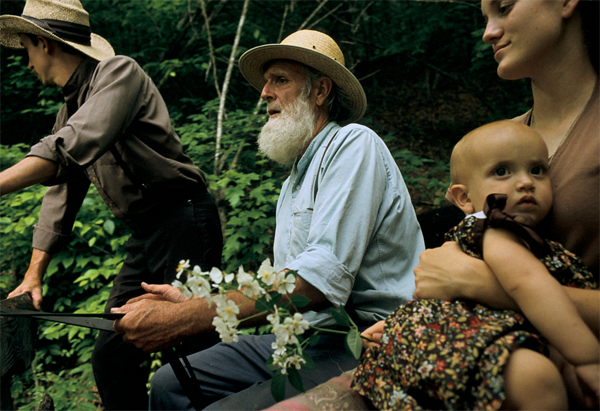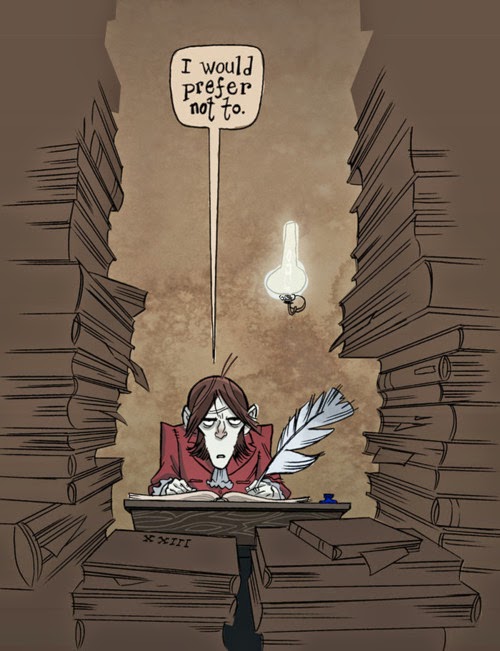I had already heard about Nathaniel’s Hawthorne book
“The Scarlett Letter”. I actually bought it because I intend to read it quite
soon. But I knew very little about the author and after the class I went to
look up on him a bit further. What caught my attention and made me do some research
as soon as I got home was a small detail mentioned by our teacher: that he had
changed is name (added the “w”) because of his ancestry, probably to distance
himself from it. It is said that it might have been because of his uncle, John
Hathorne, who was one of the judges in the Salem trials, the only one who never
repented of his actions.
 I never thought that I would finally hear
about the Salem witch trials at University, even if we aren’t going to study it
in detail. But I did my personal research and of course everything connects to
everything else – the Calvinist and puritan religious context of the time. I
actually learnt that in Salem village things were pretty harsh because of these
religious fanatics of the time. Villagers could not celebrate Easter and
Christmas because they said it had roots in paganism (which is also something
that interests me since I heard about Wicca), they had to attend to the meeting
house for a three hour sermon twice a week, and toys were almost forbidden,
specially dolls because they were regarded as a pure waste of one’s time.
I never thought that I would finally hear
about the Salem witch trials at University, even if we aren’t going to study it
in detail. But I did my personal research and of course everything connects to
everything else – the Calvinist and puritan religious context of the time. I
actually learnt that in Salem village things were pretty harsh because of these
religious fanatics of the time. Villagers could not celebrate Easter and
Christmas because they said it had roots in paganism (which is also something
that interests me since I heard about Wicca), they had to attend to the meeting
house for a three hour sermon twice a week, and toys were almost forbidden,
specially dolls because they were regarded as a pure waste of one’s time.
Reading this made me think that no
society or community is perfect. All of them have their faults and what keeps surprising
me every time through this learning process is the power of the church and the
power of faith – how it helped people and how it devastated them.
But know I want to focus on the Maypole
of Merry-Mount which was highly interesting.
We read it in class with our teacher, who
was an important guide because otherwise I wouldn’t have understood it as well
as I did.
While coming acquainted with the merry
mounters I soon became aware of the concept of hedonism that was present in their community, which strikes a huge
difference between them and the Puritans.
Merry Mounters and Hedonism
vs. Puritans and Austerity
The Merry Mounters take the concept of hedonism and carpe diem to an extreme that makes it an unsustainable kind of
life, plus they produce flowers which goes accordingly to their philosophy of
life. This way of living is utopic and clearly unsustainable, yet it can offer
interesting symbolism and contrast with the Puritan way of life. Producing
flowers could have been an extreme example used by Hawthorne to better expose
the contrast between them and the Puritans.
The characters Edith and Edgar prove that
it is no sustainable – it was not the Puritans who took them out of Merry Mount
but the very fact with their marriage, they were brought to reality. Reality
and suffering exist side by side with real life and happiness, so looking back
they understood that the merry mounters lived on false happiness or an
illusion. In my opinion, the couple represents the natural course of life. They
knew about mirth but not about love (or at least monogamous love). They learnt
that with love and happiness there is also pain because they grow in love, they
grow a higher level of conscience which makes them more vulnerable, which is
normal.
However, if I had to choose, I will
choose to live among the merry mounters. In contrast to the Puritans that were
there at the time, it is easier to find sense in their choice of life. They
might have wanted a sort of dream world, completely different from the rigid
puritan one. They did not want to worship God but Nature instead. They did not
find sense in the whipping post and in punishing people, they rather preferred
to be merry and dance around a maypole, celebrating freedom.
We can strike their difference, for
instance, by analysing their symbols. The Merry Mounters have the Maypole as a
symbol. It is the object that bounds them together, representing the idea of a
“permanent spring”, a permanent festival. The Maypole was a permanent one,
meaning that the celebration and being merry was throughout the whole year. On
the other hand, the Puritans have the Whipping Post, which can symbolise their
austere way of life and, in my opinion, a sadistic one. Puritans claimed that
whatever they did, they did it in the name of God but didn’t they find pleasure
in punishment? The human being is and always have been vicious.
Merry Mounters of today
In addition to what we have studied about
the story of Merry Mount, we acknowledged that their way of living and their
beliefs are concepts that we still find today. Some people, nowadays, hang on to
those beliefs - what we nowadays call “hippies” or “free thinkers”. Still today, we can find communities or
people that dance around a maypole for several different reasons that are now
seen as something different rather than something to be reprimanded or punished
about.
We can become acquainted with that if we
read through the article by Rich Beattie: “Maypole Festivals: Dancing to
celebrate spring”. In this article we see that dancing around the Maypole is
something quite ancient, practiced for different reasons. In the Medieval
times, for example, they did it to ensure a “fruitful planting season”.
Obviously the church disapproved of it because of its pagan roots. Fortunately
the world as changed so much, due to its relief from religious tensions and
power, that we often see some rituals or dancing happening only to celebrate
May Day as being the International Workers’ Day.
However, Beltane often is celebrated by dancing around a maypole, which
brings us back to the pagan roots. Neo-pagans
and wiccans still celebrate Beltane as the Gaelic May Day festival
held on the first of May, along with other seasonal festivals like Samhain, Imbolc and Lughnasadh.
Often we can see people celebrating Beltane by dancing around a maypole or
with bonfires, which is the case of wiccans.
From what I
have read in a book called “Ritos e
Mistérios Secretos do Wicca” by Gilberto de Lascariz, Wiccans have two
types of celebrations: Esbat and Sabat. Both celebrations have more to do
with the attainment of a higher consciousness and spiritual growth, along with
pagan rituals and by celebrating the cycles of nature. It is, therefore,
important to point out that for Wiccans, celebrating Sabats is more than agricultural festivities where they just
celebrate the cycle of the earth’s fertility.
Nowadays, in
Scotland, the Beltane Fire Festival holds
high success among those who celebrate Beltane.
This revival started in 1988. Although
the festival holds the traditional Gaelic background and reasons (which can be
many accordingly to what one believes in) it includes cultural and modern art events, which incorporates myth and drama from a variety of world cultures and diverse literary sources.
( Photos taken by Jasper Schwartz - Beltane Festival Fire, 2014)































.JPG)
.JPG)
.JPG)



.JPG)

















